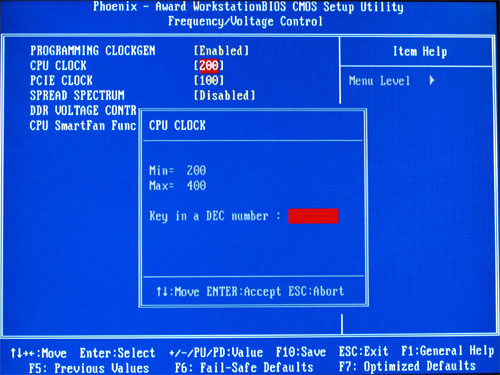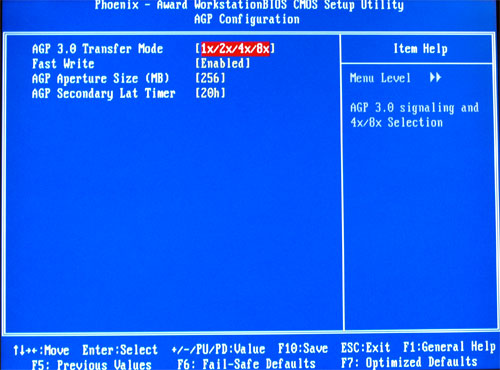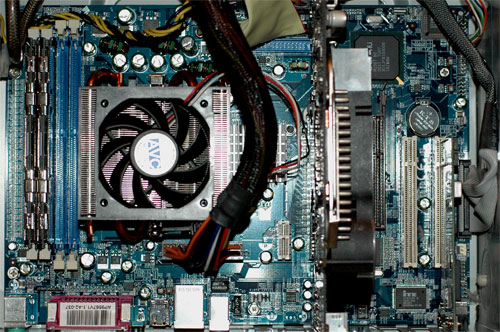FIRST LOOK: ULi M1695 PCIe/AGP Socket 939 for Athlon 64
by Wesley Fink on July 13, 2005 12:05 AM EST- Posted in
- Motherboards
Basic Features: ULi AP9507A (M1695/M1567)
| ULi AP9507A (M1695/M1567) | |
| CPU Interface | Socket 939 Athlon 64 |
| Chipset | ULi M1695 Northbridge - ULi M1567 Southbridge |
| BUS Speeds | 200MHz to 400MHz in 1MHz Increments |
| PCIe Speeds | 75-125MHz in 1MHz Increments |
| PCI/AGP | Fixed at 33/66 |
| Core Voltage | Startup, 0.825V to 1.55V in 0.025V increments |
| CPU Clock Multiplier | Startup, 4x-25x in 1X increments |
| HyperTransport Frequency | 1000MHz (1GHz) |
| HyperTransport Multiplier | 200, 400, 600, 800, 1000 |
| DRAM Voltage | NO Adjustments |
| HyperTransport Voltage | NO Adjustments |
| Memory Slots | Four 184-pin DDR DIMM Slots Dual-Channel Configuration Regular Unbuffered Memory to 4GB Total |
| Expansion Slots | 1 PCIe x16 (or 2 PCIe x8) 1 AGP 8X 2 PCIe x1 2 PCI Slots |
| Onboard SATA/RAID | 2 SATA Drives by ULi M1567 (RAID 0, 1, JBOD) |
| Onboard IDE/IDE RAID | Two Standard ATA133/100/66 (4 drives) |
| Onboard USB 2.0/IEEE-1394 | 8 USB 2.0 ports supported by ULi M1567 No Firewire (Optional) |
| Onboard LAN | 10/100 Ethernet by Realtek PNY (Gigabit LAN Optional) |
| Onboard Audio | AC '97 2.3 6-Channel by Realtek ALC655 |
| BIOS Revision | Award OC50624A (6/24/2005) |
The ULi Award BIOS provides a wide range of BIOS control options, particularly considering that this is a Reference Board used to qualify a chipset. The wide 200 to 400 range for CPU clock was a pleasant surprise, but it is somewhat academic with no memory voltage controls present in the BIOS.

The included vCore adjustments and PCIe speed adjustments were also a nice addition, although the range to just 1.55V is very limited for Clawhammer processors, which are 1.50V at default.

Since the ULi implementation of AGP is real AGP and not derived, the AGP adjustments will look familiar to AGP owners.
Reference Boards are designed for qualification and not for production. It would therefore be a mistake to dwell on the Reference Board layout, except to say that Reference Boards often influence layout of production boards. IDE, SATA, video slots and bottom edge headers all work fine where they are located. However, we hope that production boards will take a different approach to the location of the 24-pin ATX power connector. Located in about the center of the board between the CPU and rear IO ports, there is really no good way to route the heavy cable. In the center of the board, you have to be careful not to interfere with air flow or operation of the CPU and memory.
The location of the floppy connector at the bottom of the board will be a long reach for floppy users. Many buyers don't care about floppies any more, but if you still use them, the bottom of the board is an inconvenient and hard-to-reach location.











72 Comments
View All Comments
Wesley Fink - Wednesday, July 13, 2005 - link
#12 - This is a First Look with 2 days testing time for the review. There is a followup Reference Board with better options and we will be analyzing disk and I/O on that board. Testing 10/100 Ethernet tells us little about the board. Abit and Gigabyte both have full-blown boards in the works.#15 - The drivers were trouble-free in our testing. Reference Boards are famous for quirky drivers but these worked as they should.
#20 - 400 IS the speed when I set 200 Clock Speed in BIOS, so I am talking about 400 Clock Speed (800). It isn't truly FSB on an HT machine, so I've changed the wording and the DDR reference error to make it better understood. We are expecting the second Reference Board with improved overclocking shortly and will do more testing for a Part 2 with that board.
nserra - Wednesday, July 13, 2005 - link
Wesley Fink i noted that the speed of the AGP is very good, but vs the older 1689 is it equal, higher or is the 1689 even higher. Can you do some 939A8X-M test just to check.#20 He mean 400Mhz. Thats a typo.
Uli say their chipset would do 400Mhz bus speed i just dont know it it's 400x5 or 2000 HT.
PrinceGaz - Wednesday, July 13, 2005 - link
Page 4 Overclocking - "Since there were no voltages for memory, we had to toss our normal overclock procedures out the window" and "Without memory voltage, the only way that this can be tested is by lowering memory ratios to those that can run at default voltage"Since you like promoting OCZ products and they seem more than happy to send you them (you used OCZ memory and PSU for this test), why not ask OCZ to send you a pair of their DDR Booster things?
From the same paragraph- "We have seen reports that this new ULi Reference Board, or more specifically the sister Reference Board with the dual 8X riser slot, can reach a FSB setting of DDR400"
Reach an FSB setting of DDR400? Isn't that the default memory speed anyway? I certainly hope it can reach DDR400! :) Did you mean that it can reach 400MHz FSB?
probedb - Wednesday, July 13, 2005 - link
This is fantastic. I was wanting a skt939 mobo in a server but all the PCIe RAID boards I've seen need an 8x socket which currently nothing except servers support in tandem with a gfx card. The fact that you could get more than 20 lanes is brilliant news for me :)SynthDude2001 - Wednesday, July 13, 2005 - link
#17 - OMG. I want one now!Any ideas if this will be able in the near future too? (Say, within a month or maybe two)
stmok - Wednesday, July 13, 2005 - link
If you need Linux driver support for ULi chipsets, head to ocworkbench.com forums OR search/contact ULi about it.I know the previous generation, M1689 chipset did work without a problem in Linux. (I used Fedora Core 4, Gentoo and Slackware).
I was already excited about this chipset (M1695) MONTHS ago...It must take quite a bit of time to get the word out from Taiwan to USA.
If you thought the chipset was interesting.
Check out what ASRock is gonna do with it!
They have a mobo under development that uses this chipset and have an upgrade option to support future Socket M2 CPUs.
Don't believe me?
ASRock 939Dual-SATA (formerly ASRock 939Dual-M2)
http://forums.techwatch.com.au/viewtopic.php?t=448...
SO what do we have here?
(1) PCI-Express and AGP support (no performance loss)
(2) SLI capable. Over at ocworkbench, they have an article which demonstrates that the M1695 DOES support SLI. The special dual PCI-Express 8x riser card is only a prototype (consider it a concept demonstrator), and NOT a retail product...Either way, SLI on M1695 works...And performance is identical to NF4 SLI.
(3) Dual-core support. (both the older M1689 and newer M1695 can handle dual-core without issues).
(4) Overclocking. (ocworkbench.com has shown the newer M1695 has PCI/PCI-Express/AGP locks, and it can handle very high overclock bus speeds)...The current M1689 does NOT have PCI/AGP locks. So ULi did listen to the enthusiast crowd. :)
(5) Upgradeability (ASROCK only)...Who wouldn't want a mobo that supports Socket M2 as well as Socket 939? :)
(6) Its marketed to be slightly cheaper than VIA chipsets!
(7) Abit, ASUS, ASRock, Gigabyte are some mobo manufacturers that have released mobos based on ULi chipsets, and they're working on products with the newer M1695.
Its not surprising that ULi is offering so much. They have been noted for saying they want to be the very best Taiwan based chipset provider. And from the looks of it, they're getting there quite well with the M1695.
Calin - Wednesday, July 13, 2005 - link
Me three :DCalin
Googer - Wednesday, July 13, 2005 - link
Quality drivers will make or break the deal on this chipset.Quality Hardware counts too, but drivers are a deal maker or breaker.
SynthDude2001 - Wednesday, July 13, 2005 - link
Absolutely amazing. Assuming they allow for a bit more overclocking options (voltages mainly), and that it does appear in August like they say it will - this WILL be my next motherboard.My 6800GT still has a lot of life left in it I think, but the Athlon XP finally needs to go. I can pick up an X2 and one of these boards, use my 6800GT for now, throw in an R520 or '7800 Ultra' later, and probably be set for at least a year, maybe two.
I can't wait to see these appear at retail!
Cygni - Wednesday, July 13, 2005 - link
Thats the most important thing for ULI right now. They need somebody, ANYBODY, to make a board with 2 physical PCI-Ex 16x slots AND agp 8x. The riser card is great in that it proves that it works (and that SLI works as fast as a Nforce 4 SLI board as seen on OCWorkbench), but it aint going to fit in any case that ive seen. 2 PCI-Ex 16, an AGP, 2 PCI, and a PCI-Ex 4 slot... and we got one beautiful board.Judging by past ULi/ALi pricing, it will be dirt cheap too. Actually, i dont think we need to worry so much about whos gonna make it... a quick search on Newegg shows that ASRock, Gigabyte, Abit, Albatron, and Chaintech are all making boards based on the less exciting 1689 chipset.
Im excited. Amazing AGP performance, solid PCI-Ex performance WITH full on SLI, and a low price. Perfect for a few upgrades to K8-ville.